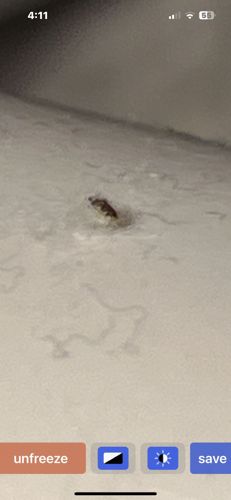Cockroach (likely German Cockroach or similar small species)
Scientific Name: Blattodea (Order), Blattellidae (Family, for German Cockroach)
Order & Family: Order: Blattodea, Family: Blattellidae (e.g., German Cockroach), or Blattidae (e.g., American Cockroach) depending on specific species.
Size: Typically 1.1 to 1.6 cm (0.43 to 0.63 in) for species like the German Cockroach, but can range larger for other species up to 4 cm (1.6 in). The one in the image appears smaller.

Natural Habitat
Found in buildings, especially kitchens and bathrooms, preferring warm, humid, and dark areas close to food and water sources. They are nocturnal and gregarious.
Diet & Feeding
Omnivorous scavengers. They eat almost anything, including human food scraps, grease, crumbs, pet food, toothpaste, soap, glue, and even other cockroaches when food is scarce.
Behavior Patterns
Nocturnal, hiding in cracks and crevices during the day. They are fast runners and can exhibit thigmotaxis (preference for enclosed spaces). They reproduce rapidly and can quickly infest an area. They leave behind a chemical trail for other cockroaches to follow.
Risks & Benefits
Risks: Can be vectors for pathogens (bacteria, viruses, fungi, protozoa), contaminating food preparation surfaces and food. Their droppings and shed skins can trigger allergies and asthma in sensitive individuals. They are considered pests. Benefits: In natural ecosystems, some species play a role as decomposers, but in human habitats, they are overwhelmingly considered a nuisance and health risk.
Identified on: 11/16/2025